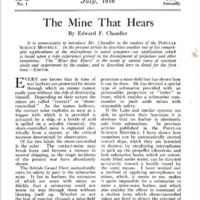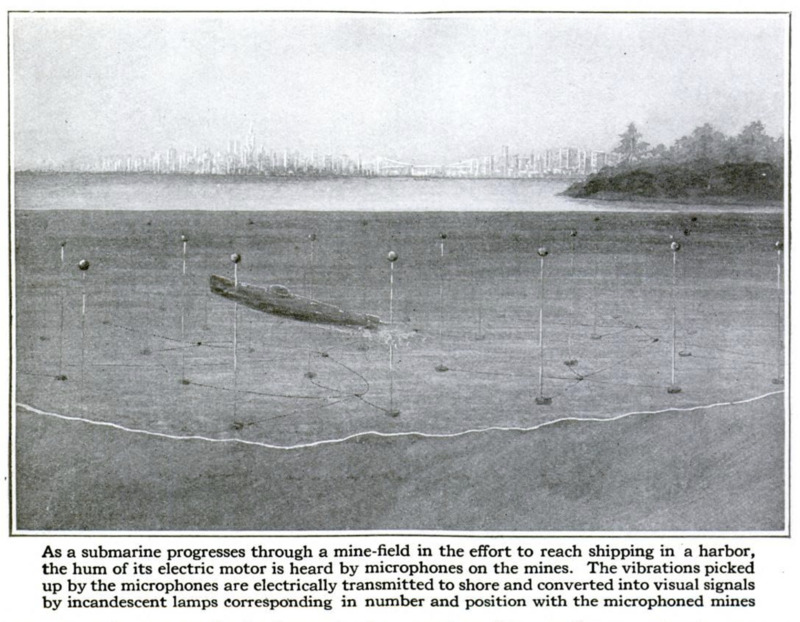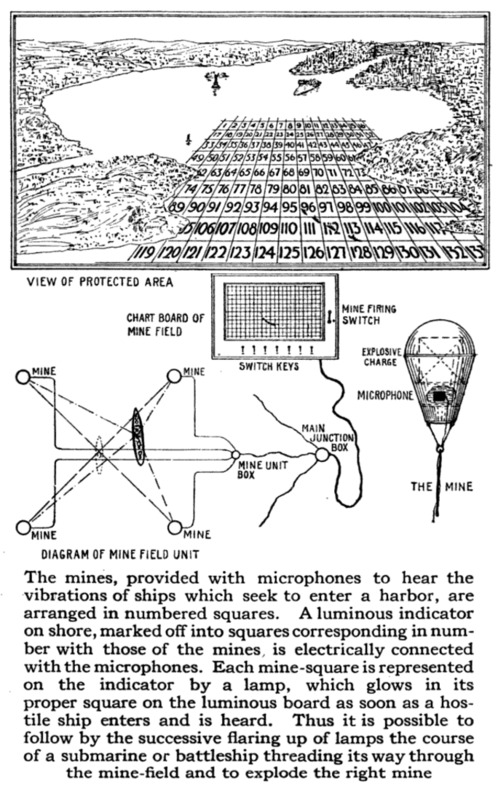-
Title (Dublin Core)
-
The Mine That Hears
-
Article Title and/or Image Caption (Dublin Core)
-
The Mine That Hears
-
Caption 1: As a submarine progresses through a minefield in the effort to reach shipping in a harbor,
the hum of its electric motor is heard by microphones on the mines. The vibrations picked
up by the microphones are electrically transmitted to shore and converted into visual signals
by incandescent lamps corresponding in number and position with the microphoned mines
-
Caption 2: The mines, provided with microphones to hear the vibrations of ships which seek to enter a harbor, are arranged in numbered squares. A luminous indicator on shore, marked off into squares corresponding in number with those of the mines is electrically connected with the microphones. Each mine-square is represented on the indicator by a lamp, which glows in its proper square on the luminous board as soon as a hostile ship enters and is heard. Thus it is possible to follow by the successive flaring up of lamps the course of a submarine or battleship threading its way through the mine-field and to explode the right mine
-
extracted text (Extract Text)
-
EVERY one knows that in time of
war harbors are protected by mines
through which an enemy cannot
easily pass without the risk of destroying
himself. Depending on their nature the
mines are called “contact” or “shore-
controlled.” As the names indicate,
the contact mine explodes as soon as a
trigger with which it is provided is
actuated by a ship, or a bottle of acid
is spilled on a suitable chemical; the
shore-controlled mine is exploded elec-
trically from a station at the critical
moment determined by observation.
Of the two kinds the shore-controlled
is the safer. The contact-mine may
break loose and become a menace to
neutral shipping, as the tragic incidents
of the present war have abundantly
shown.
The British Grand Fleet undoubtedly
owes its safety in part to the submarine
mine. It lies in harbors the entrances
of which are sown with mines so
thickly that a submarine could not
worm its way through them without
blowing itself up. Whether or not
the feat of running through a mine-field
has actually been performed in the
war there is at least reason to believe
that it has been attempted. Mr. Simon
Lake, a leading authority on submarine
boat construction in this country, not
only declares that a submarine can
penetrate a mine-field but has shown how
it can be done. He has devised a spécial |
type of submarine provided with an |
antennalike projection or “feeler” in |
front, which enables a submarine com- |
mander to push aside mines with
reasonable safety. |
If the Lake and similar systems are |
able to perform their functions it is
obvious that no harbor is absolutely
safe from submarines. In previous
articles published in the PoruLar
Science MoNTHLY, I have shown how
torpedoes can be automatically steered |
toward ships, which they are intended |
to destroy, by employing microphones |
to pick up the propeller vibrations, and
how submarine boats, which are notori- |
ously blind under water, can be directed |
accurately toward a hostile vessel by |
the same means. I have worked out |
a method of applying microphones to |
mines, which, it seems to me, makes
it quite impossible for a submarine to |
enter a mine-sown harbor, and which
also enables the officer in command of |
a station from which shore-controlled |
mines are fired to detect the attempt of |
a surface vessel to enter under the cloak |
of a dense fog. |
The system which I have devised |
would render it possible to blow up a
submarine trying to worm its way into
a mine-protected harbor, or a battleship
2 to enter a harbor at night or in
ise fog. In my system the mines
arranged in groups of four, each
group constituting a field unit. On each
mine a microphone is mounted. * These
microphones literally hear the hum of a
submarine’s motor. Not only that but
the particular microphone which hears
the submarine best, because it is the
nearest to it, can easily be located. Tt
is simple enough to determine whether a
submarine is nearer mine 1 or mine 2 of
a given field unit of four mines.
“For the benefit of those who may be un-
familiar with the microphone 1 may state that
the microphone is an instrument for intensifying
feeble sounds or for transmitting sounds and it
is based on the principle that the transition
between loosely-joined electrical conductors
decreases in proportion as they are pressed to-
gether. The conductors form part of a circuit
through which a current is passing, and the
variations in pressure due to sound waves in the
vicinity of the conductors produce variations
of resistance and fluctuations of the current
co that the sounds are reproduced in a
telephone receiver. In the modern telephone
the transmitter is essentially a microphone, the
pressure of the sound waves being communicated
to the conductors by means of a diaphragm.
The field units are interconnected
electrically, so that the entire harbor is
sown not only with charges of high
explosive but with microphone detectors.
Interconnection is necessary because
mines 1 and 2 of one group constitute
mines 3 and 4 of an adjacent group.
Microphones are so remarkably sensitive
(they have picked up the hum of sub-
marines fifteen miles away in the present
war) that they need not be lavishly
employed in every case. Four micro-
phones placed in the four corners of a
small field would answer in many cases,
all the more so, since a ship can be
blown up even though it be fifty feet
from the actual explosion. Few of us
realize how terrific is the disruptive
effect of the gases suddenly generated
when several hundred pounds of explo-
sive are detonated.
A minefield equipped with micro-
phones in the manner indicated is
electrically connected with a luminous
annunciator. In other words, wires
run from each microphone to a board
which is divided into squares correspond-
ing in number with those of the mine-
field units. Behind each square a lamp
is mounted. As a hostile ship passes
through a mine-field the nearest micro-
phones pick up the vibrations of her
propellers and the corresponding lamps
on the board glow. The luminous
annunciator may be twenty or more
miles distant from the microphones;
it may be in
Chicago _and
the mine-
field in New
York Harbor,
if there were
any military
advantage in
that great
separation.
It is always
posible to
ollow the
course of an
intruding ves-
sel merely by
watching the
lights as they
flare up and
die out in the
squares of the
Juminous
annunciator.
The lamps ac-
tually visualize
the course tak-
en by the
vessel under
observation.
If she enters
square 22 of
the field the
lamp behind
square 22 on
the _annuncia-
tor board
glows; as she
slips into square 23 of the mine-field,
lamp 22 is extinguished and lamp 23
flares up. The accompanying diagram
will explain the general principle.
Mines are expensive. To provide
them with microphones and to wire the
microphones to a luminous annunciator
board adds to the cost of the installation.
Suppose that it were possible to use
fewer mines, in other words, to use
rather large squares, and suppose that
it were possible to determine not merely
the particular square into which a
hostile vessel has found its way but
the particular mine of that square
nearest which it happens to be—would
not that solve the problem of cheapening
the installation and heightening its
effectiveness?
With this idea in mind I have connec-
ted with the
luminous
annunciator
board what
may be called
a “precision
indicator,” the
purpose of
which is to
show which
mine is to be
exploded in
order to des-
troy the inter-
loper. A single
precision indi-
cator serves
for all the
mines; for
the wiring is
such that the
precision
indicator can
be switched
into the circuit
of any mine-
square at will.
The details
cannot be
revealed at the
present time,
ecause they
are the subject
of a patent
application
awaiting
official action.
It may be stated, however, that the
devices employed accurately locate a |
vessel in a square by averaging the |
momentary responsiveness of the four |
microphones at the corners of the square. |
Itis very much as if a pencil were attach.
ed by four cords to as many pulling |
devices, the pull on each cord coming |
from a different point of the compass and
representing the intensity of the sound
heard in a microphone.” Pulled in all
four directions at once, but with different
intensities, the pencil will rest at that
point where all the forces are equalized.
That point, in the case of the precision
indicator, is the spot in which the hostile
vessel is to be found.
Imagine New York Harbor mined
and microphoned in the manner that
I have described; imagine the mines
connected with a luminous annunciator
at Fort Wadsworth and with a precision
indicator provided for the purpose of
determining which microphone in a
square hears the most; imagine a
submarine crawling very, very cautiously
through the field, thrusting aside with
careful antenna, the anchor-chains of the
buoyant mines in its path. An American
officer glues his eyes on the luminous
board. One by one the squares glow
before him—19, 36, 53, 66. Unwittingly
the submarine’s commander plots his
course in a trail of light. He cannot
be seen with human eyes; and yet he
is as visible, electrically at least, as a
goldfish in a glass bowl. “Square 78,"
says the American officer to himself, as
a new light flashes up. The time has
come for decisive action. He pulls a
handle and switches the precision indi-
cator into electrical connection with
square 43. The submarine is nearest
mine “A” of that unit, for the micro-
phone on mine “A” is intensely active.
He presses a button. Miles away a
column of water is tossed into the air.
An unseen enemy has been destroyed
with awful suddenness; twenty brave
sailors have been killed with merciful
swiftness by a man who never saw their
faces.
The naval and military strategist
will note at once that the system which
1 have described has this advantage
over the rather haphazard method of
utilizing the contact mines at present
employed. It renders it possible to
destroy a whole fleet, ship by ship, as
it progresses into a harbor which is
protected. The officer at the luminous
indicator board has only to wait until
the lamps show that the entire squad-
ron has entered the field to blow up
ship after ship at his pleasure. It is
also apparent that the system is not
limited in its application to the de-
tection of battleships or submarines in
a minefield, but that it can also be
adapted to the firing of coast-defense
shore-batteries.
-
Contributor (Dublin Core)
-
Edward F. Chandler (writer and inventor)
-
Language (Dublin Core)
-
eng
-
Date Issued (Dublin Core)
-
1916-07
-
pages (Bibliographic Ontology)
-
3-6
-
Rights (Dublin Core)
-
Public Domain (Google digitized)
-
Archived by (Dublin Core)
-
Filippo Valle
-
Alberto Bordignon (Supervisor)
 Popular Science Monthly, v. 89, n. 1, 1916
Popular Science Monthly, v. 89, n. 1, 1916





